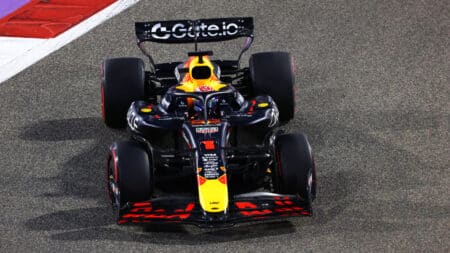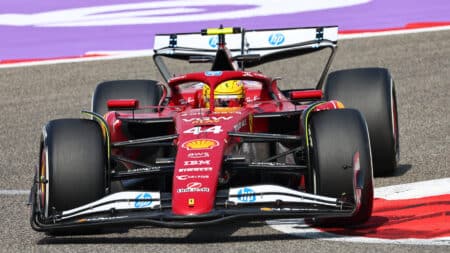
How 'everything went wrong' for Verstappen and Red Bull in Bahrain
A trying Bahrain GP has left Red Bull and Max Verstappen facing the reality that the titles may be slipping away
A series taken from the 164-page Motor Sport special Great Racing Cars, which is available to buy here.
To buy the lead image click here.
From the editor Damien Smith
How would you define a ‘great’ racing car? Race wins and championship titles are an obvious place to start – and admittedly, when we began the process of rounding up the ‘voices’ to fill this special magazine, published by the team behind Motor Sport, we had in mind the likes of the Lotus 72, Ferrari F2004, Porsche 917, Audi R10 and so on.
But as the interviews of familiar racing figures began, we realised greatness is often a very personal thing. Naturally, most – but not all – would pick cars they had experienced first-hand, as a driver, designer, engineer or team boss. And on occasion the cars that stood out in their minds as ‘great’ weren’t necessarily so in the grand scheme of history. That’s why you’ll find a Minardi here among Formula 1 cars from Lotus, Williams and McLaren.
Unexpected? Certainly. Wrong? Not to the man who chose it.
As the interviews accumulated, our magazine took on a life of its own, full of personal anecdotes about the myriad cars that made careers. Some of those we spoke to, such as Mario Andretti and Dan Gurney, couldn’t be tied to a single choice from multi-faceted lives at the wheel. Such heroes have earned the right to choose an F1, sports and Indycar, so we allowed them more than one bite.
Others refused to be confined by category. Hence the short ‘Odd ’n Sods’ chapter on cars that, by and large, are mere footnotes in lower divisions of racing lore.
Thus there is nothing definitive about the selection listed herein. Then again, there’s no claim that this compilation offers the ‘Greatest Racing Cars’ of history. It’s much more personal than that, much more quirky – and all the better for it.
Emerson Fittipaldi
Two-time F1 World Champion and Indy 500 winner
I have driven so many great cars, in both Grand Prix racing and in Indycar, so choosing one is really impossible.
However, 2014 is the 40th anniversary of my World Championship victory in the McLaren M23, my second championship but a first for the McLaren team.
Entrant: McLaren
Drivers: Emerson Fittipaldi, James Hunt, Peter Revson, Denny Hulme, Jochen Mass, Jacky Ickx, Jody Scheckter, Gilles Villeneuve
Debut: 1973 Spanish Grand Prix
Achievements: 16 wins, 14 poles
Constructors’ Championships: 1 (1974)
Drivers’ Championships: 2 (1974, 1976)
Leaving Team Lotus and Colin Chapman was not an easy decision – the Lotus 72D was one of the great Formula 1 cars of all time – but in ’73 the new 72E was not so good.
I liked the potential of McLaren, they wanted to win, they wanted a championship, there was good money from Marlboro and Texaco, and the M23 had won races in ’73. It was a strong car, well engineered, and reliable. I liked the team, the way they worked – not a big team but very efficient – and they had a huge desire to win.
Working with Gordon Coppuck was good: we tried long wheelbase, short wheelbase, the car was very adaptable for different circuits. It wasn’t as sophisticated as the Lotus but it was very driveable and I knew we could win races.
We took the M23 to Paul Ricard in the winter of ’73 and it was immediately fast on the short circuit. There were things I’d learnt from the Lotus 72, we developed a longer wheelbase, a wider track, and that gave the car better weight distribution and more traction. We kept on working with Gordon and I knew we could win – but I never imagined we’d get the championship in that first year.
The car felt really good at Interlagos; I was on pole and won the race. My home Grand Prix, imagine that. The race was stopped eight laps early because of heavy rain, Clay Regazzoni was second for Ferrari, and at the end of the season at Watkins Glen it was between the two of us for the World Championship. I have never felt so much pressure, not ever, but Clay was delayed by a pitstop and fourth place was enough to win my second championship, the first ever for McLaren, and the Constructors title for the M23. When I drive the car now, 40 years later, I have many good memories.
The infamous M23 racer
Jody Scheckter on the car he raced – and crashed in 1973
Despite the promise shown in Kyalami 1972, Scheckter had doubts about how ’73 would turn out. McLaren had canned its F2 programme, and with Denny Hulme and Peter Revson the first choices in F1, only occasional GP outings were on offer. When opportunities arose, he needed to make the most of them.
At Paul Ricard — just his third GP — Scheckter found himself in Gordon Coppuck’s new M23, a car that would turn out to be one of the most successful in F1 history. In France, Jody led sensationally until 12 laps from the end, when Emerson Fittipaldi made a move and the pair ended up in the catch fencing. If they hadn’t already noticed before, they knew now: Scheckter had arrived.
But his rise would be pulled up short at Silverstone in July, when he triggered the infamous nine-car pile-up that decimated John Surtees’ team. Jody hid in the team motorhome.
After a couple of late-season appearances, Scheckter moved on from McLaren, frustrated by the lack of opportunity. As for the M23, it would rack up 16 GP wins over four seasons and carry James Hunt to the ’76 world title.
“People think of me in this car at Silverstone, with the big pile-up, but I prefer to think of Paul Ricard that year. I was competitive. It was the only time I had a senior driver in the same team as me, in Denny. When I got to Tyrrell in 1974, I was the senior driver. That didn’t worry me at the time, but I wonder if I could have become more competitive by continuing alongside someone like Denny. McLaren was one of the more advanced teams back then. At Tyrrell I felt they were behind McLaren. And if you look at the cars now you’ll see how refined they were compared to cars that came even much later.”
Taken from the February 2013 issue of Motor Sport. To read the full article click here.

A trying Bahrain GP has left Red Bull and Max Verstappen facing the reality that the titles may be slipping away

Oliver Bearman contributed to a great day for Haas in the Bahrain GP by finishing 10th from last on the grid. Here's how he did it

After struggling to get to grips with his Ferrari, Lewis Hamilton says moving towards Charles Leclerc's set-up made a difference in Bahrain

A second F1 win in three grands prix has made Oscar Piastri look like the stronger McLaren driver, as Lando Norris admitted he is struggling to find answers